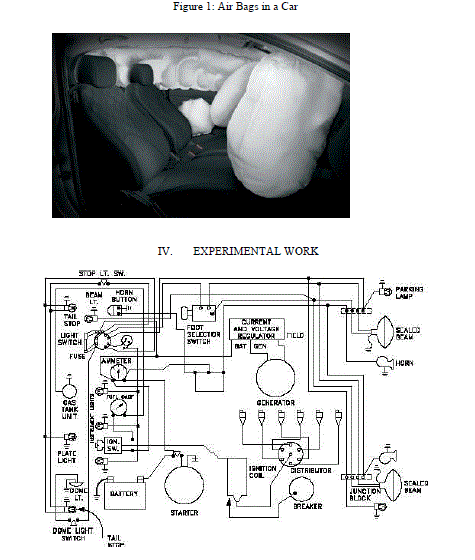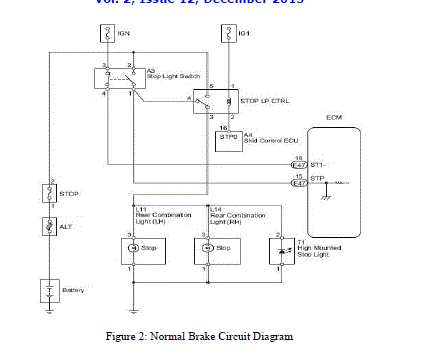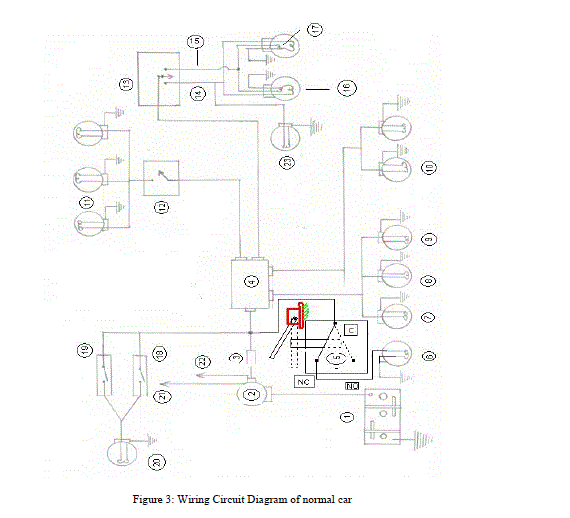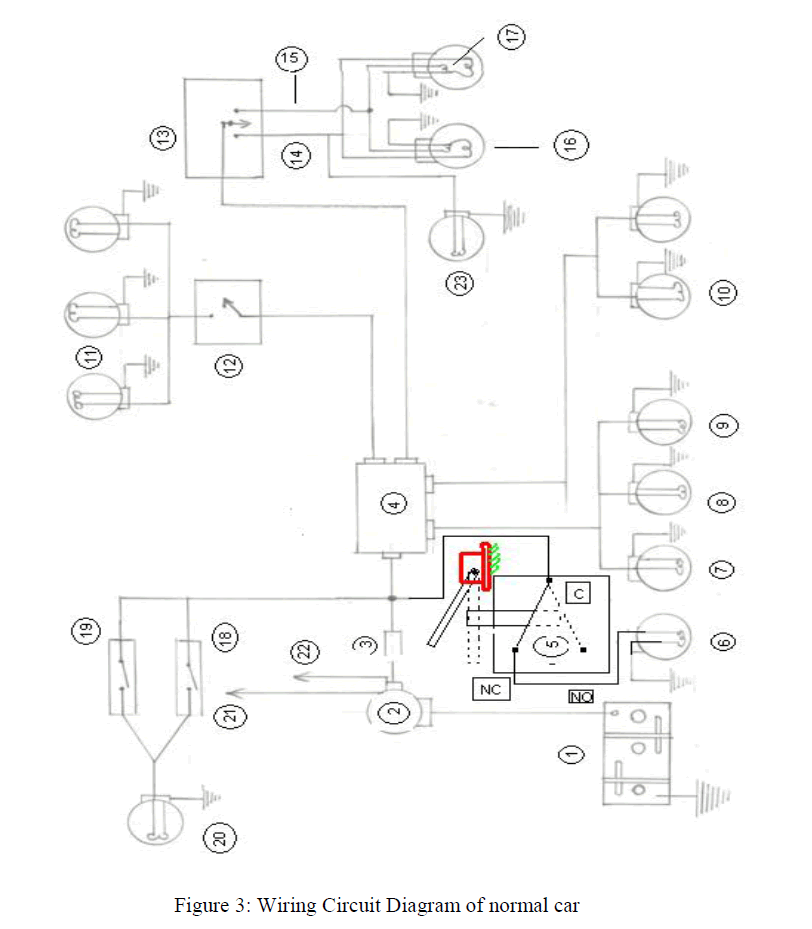ISSN ONLINE(2319-8753)PRINT(2347-6710)
ISSN ONLINE(2319-8753)PRINT(2347-6710)
Dr.A.Aruna Kumari1, V.Siva Rama Krishna2
|
| Related article at Pubmed, Scholar Google |
Visit for more related articles at International Journal of Innovative Research in Science, Engineering and Technology
It (ABAS) means alerting the following vehicles in advance by using the advanced brake alert system which the brake light work when removed the pressure on accelerator pedal where as in the present system which the brake lights comes on by applying the pressure on the brake pedal to reduce the vehicle speed or to stop the vehicle according to necessity. Normally brake light works when we apply the pressure on the brake pedal to reduce the vehicle speed or to stop the vehicle, so that we can alert the following vehicles by giving this instruction. In the above mentioned advanced brake alert system (ABAS) the brake lights comes on when removed pressure on the accelerator pedal there by the advanced instruction to the following vehicles for safe driving and keep away from the accidents. By using the (ABAS) we can reduce the sudden accidents effectively and thereby decreasing the accidental deaths
Keywords |
| ABAS, Brake lights, Brake, Accelerator pedal, Vehicle, ABS |
I. INTRODUCTION |
| The Vehicle had been started, accelerated and was running on the road. It is now to be stopped. Stopping of the vehicle is as necessary as its starting. Once the vehicle is started, it must be stopped somewhere. Brakes are applied on the wheels to stop the vehicle. Before applying the brakes, acceleration is released to stop the fuel supply system thus the engine develops no more power to run the vehicle, and then the brakes are applied which stop rolling of the wheels on the road and hence the vehicle is stopped. Clutch is also disengaged which connects the engine from transmission system. Thus, when the vehicle is standing, the engine is still running at idling. Create enough deceleration to stop the car as quickly as the driver wishes, without exceeding the drivers comfort level with regard to pedal effort or pedal travel. The brake system coverts the kinetic energy into heat |
II. LITERATURE SURVEY |
| In this article, the last in a six-part series on brakes, we'll learn all about anti-lock braking systems -- why you need them, what's in them, how they work, some of the common types and some associated problems. The theory behind anti-lock brakes is simple. A skidding wheel (where the tire contact patch is sliding relative to the road) has less traction than a nonskidding wheel. If you have been stuck on ice, you know that if your wheels are spinning you have no traction. This is because the contact patch is sliding relative to the ice (see brakes: how friction works for more). By keeping the wheels from skidding while you slow down, anti-lock brakes benefit you in two ways: You'll stop faster, and you'll be able to steer while you stop. |
| There are four main components to an ABS system: |
| Speed sensors |
| Pump |
| Valves |
| Controller |
| Speed Sensors |
| The anti-lock braking system needs some way of knowing when a wheel is about to lock up. The speed sensors, which are located at each wheel, or in some cases in the differential provide this information. Valves |
| There is a valve in the brake line of each brake controlled by the ABS. On some systems, the valve has three positions: |
| • In position one, the valve is open; pressure from the brake cylinder is passed right through to the brake. |
| • In position two, the valve blocks the line, isolating that brake from the master cylinder. This prevents the pressure from rising further should the driver push the brake pedal harder. |
| • In position three, the valve releases some of the pressure from the brake. Pump |
| Since the valve is able to release pressure from the brakes, there has to be some way to put that pressure back. That is what the pump does; when a valve reduces the pressure in a line, the pump is there to get the pressure back up. |
| Controller |
| The controller is a computer in the car. It watches the speed sensors and controls the valves. ABS at Work |
| There are many different variations and control algorithms for ABS systems. We will discuss how one of the simpler systems works. The controller monitors the speed sensors at all times. It is looking for decelerations in the wheel that are out of the ordinary. Right before wheel locks up, it will experience a rapid deceleration. If left unchecked, the wheel would stop much more quickly than any car could. It might take a car five seconds to stop from 60 mph (96.6 kmph) under ideal conditions, but a wheel that locks up could stop spinning in less than a second. The ABS controller knows that such a rapid deceleration is impossible, so it reduces the pressure to that brake until it sees acceleration,[8] then it increases the pressure until it sees the deceleration again. It can do this very quickly, before the tire can actually significantly change speed. The result is that the tire slows down at the same rate as the car, with the brakes keeping the tires very near the point at which they will start to lock up. This gives the system maximum braking power. When the ABS system is in operation you will feel a pulsing in the brake pedal; this comes from the rapid opening and closing of the valves. Some ABS systems can cycle up to 15 times per second. |
III. AIR BAGS |
| Air bags have saved thousands of lives since their introduction in the early 1980s. If you run into something, your air bag can inflate in less than a tenth of a second to protect you from the forces of a head-on collision. There are three parts to an air bag. First, there is the bag itself, which is made of thin, nylon fabric and folded into the steering wheel or the dash board. Then there is the sensor that tells the bag to inflate. It detects a collision force equal to running into a brick wall at 10 to 15 miles per hour (16 to 24 kmph). |
| Finally, there is the inflation system. Air bags are actually inflated by the equivalent of a solid rocket booster. Sodium azide (NaN3) and potassium nitrate (KNO3) react very quickly to produce a large pulse of hot nitrogen gas. This gas inflates the bag, which literally bursts out of the steering wheel or dashboard as it expands. About a second later, the bag is already deflating (it has holes in it) in order to get out of your way. In this article, you'll learn about the science behind the airbag, how the device works, what its problems are and where the technology goes from here. |
 |
IV. EXPERIMENTAL WORK |
 |
 |
 |
| 1) Battery 2) Ammeter 3) Fuse or Circuit Breaker 4) Light Switch 5) Stop Light Switch 6) Stop light. 7) Tail Light 8) License Ligh 9) Tail Light 10) Parking Light 11) Instrument light 12) Instrument switch 13) Dimmer Switch 14) Upper Beam 15) Lower Beam 16) Head Lights Upper Beam 17) Head light lower beam 18) Dome Light Switch 19) Automatic Switch 20) Dome Light 21) Line to generator 22) to ignition switch 23) Beam indicator |
| The Present circuit is modified by replacing the operational brake pedal switch by operational accelerator pedal switch to light up the stop light switch. |
| Circuit Operation |
| The stop light switch is replaced by NC NO micro switch which is operating by the accelerator pedal circuit from the battery positive through a fuse is connected to the „C‟ (Common) terminal. The NC (normally closed) contact is connected to the stop light switch to „+‟ve in put. „-„ve of the stop light is already connected through body earth of the vehicle. Whenever the accelerator pedal is pressed the NC contact is broken by the action of the internal lever mechanism. The battery supply is now connecting from „C‟ terminal to the NO terminal. Since the NO terminal is left open, the electric supply does not go any further simultaneously since the NC contact, (which is directly connect to the stop light switch), is disconnected from the common terminal NO power supply goes to stop light switch and hence the light does not glow. When the Accelerator pedal is released the contact is again established between C and NC contact of the micro switch, allowing the current to flow to the stop light switch and light it up. |
| Material Used |
| NC NO micro switch of 25 volts, 1 amp rating used as the system operates on 12 volts vehicle battery. |
V. RESULTS |
| By implement the advanced brake alert system (ABAS) we can get the good results in the automobile industry. |
| 1. Based on above analysis I improved the alert system, so that reduce the fatal accidents |
| Some of the advantages of advanced brake alert system (ABAS) are mentioned below. |
| 1. No additional cost is required. |
| 2. Easy to Installation. |
| 3. Decreasing the fatal accidents. |
| Keep away the vehicles from accidents there by save the human lives. |
VI. CONCLUSION |
| I understand the two things from the above mentioned articles which are mentioned below. |
| i. The Anti Locking Brake System (ABS) saying that to stabilize the vehicle on curved path, slippery roads during sudden controlling at high speeds. |
| ii. The Air bags are provided to protect the rider after happening of collisions. |
| From above two points one thing I can say that the (ABAS) advanced brake alert system is important to avoid the accidents there by percentage of deceased can be reduced prior to fatal accidents by giving the advanced light indications to the following vehicles which will work when release the pressure on the accelerator pedal. |
| By using the advanced brake alert system we can give indications to the vehicles thereby reduce the sudden accident. |
References |
|